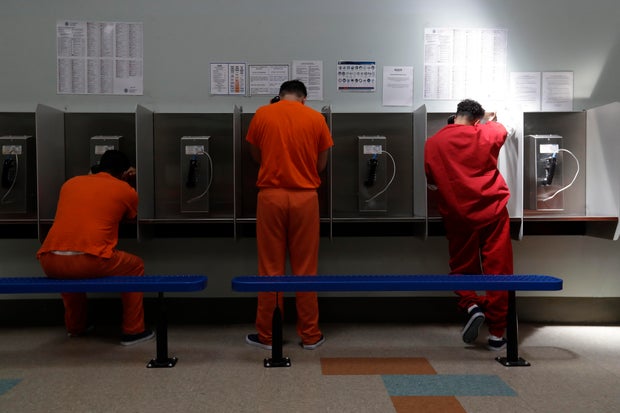CBS News
Trump and allies mischaracterize data on immigrants with criminal convictions. Here’s context on what the numbers actually show.

In recent days, former President Donald Trump and his allies have cited recently released data on immigrants with criminal convictions to claim that the Biden administration has allowed tens of thousands of criminals into the U.S., including thousands of murderers and sexual offenders.
“Kamala should immediately cancel her News Conference because it was just revealed that 13,000 convicted murderers entered our Country during her three and a half year period as Border Czar,” Trump wrote in a social media post Friday. “Also currently in our Country because of her are 15,811 migrants convicted of rape and sexual assault.”
Trump was presumably citing a letter U.S. Immigration and Customs Enforcement recently shared with Texas Republican Rep. Tony Gonzales. The letter, which Gonzalez published on Friday, contained figures on immigrants with criminal records being tracked by ICE but not detained by the agency. Trump and right-wing figures have mischaracterized the data by claiming that everyone on the list entered under the Biden administration and remains freely in the U.S.
The bottom line is that many of the convicted criminals described in the letter have been in the U.S. for a long time, before the Biden administration took office, according to government data and officials. Some are still in federal or state custody serving criminal sentences and are likely to be arrested by ICE. And others cannot be deported because their home countries won’t take them back or they received legal relief from deportation in immigration court.
What does the data actually show?
The letter ICE sent to Gonzales broke down the number of immigrants with criminal convictions or charges in the agency’s “non-detained docket.”
ICE detains immigrants who are deportable because they are in the U.S. illegally, after crossing a border unlawfully or overstaying a visa, or because they lost their legal right to be in the country after being convicted of certain crimes. Under U.S. law, this can happen to green card holders and other legal immigrants who commit certain crimes.
Chris Carlson / AP
While the agency runs detention facilities to hold immigrants awaiting deportation, ICE also oversees a “non-detained docket” to monitor the cases of immigrants who are facing deportation proceedings before an immigration judge, without being detained by the agency.
The number of non-detained docket cases has ballooned under the Biden administration, fueled by the release of millions of migrants from the U.S.-Mexico border in recent years. ICE is currently tracking roughly 7.7 million non-detained cases, up from 3.3 million in fiscal year 2020, according to agency data provided by a U.S. official. The agency has 41,000 detention beds funded by Congress — not nearly enough to detain everyone facing removal proceedings.
The letter to Gonzales shows that out of millions of cases, ICE’s non-detained docket includes 425,000 immigrants with criminal convictions and 222,000 with pending criminal charges. The list includes 13,099 immigrants convicted of homicide and 15,811 convicted of sexual assault.
Not every person arrived under Biden
Not every immigrant with a criminal record on ICE’s non-detained docket arrived in the U.S. under President Biden’s tenure. In fact, official figures indicate many of them have been here for years — if not decades.
In June 2021, just several months into the Biden administration, there were 405,786 convicted criminals in ICE’s non-detained docket, according to agency data. In August 2016, during the Obama administration, there were 368,574 convicted criminals in ICE’s non-detained docket, according to data published by the Department of Homeland Security’s Office of Inspector General.
“The data goes back decades; it includes individuals who entered the country over the past 40 years or more, the vast majority of whose custody determination was made long before this Administration,” DHS spokesperson Luis Miranda said in a statement to CBS News.
Some remain incarcerated in federal or local facilities
While they’re not in ICE’s custody, many of the convicted criminals or criminal suspects in the agency’s non-detained docket are still incarcerated in federal, state or local custody serving their criminal sentences or awaiting trial, U.S. officials told CBS News. But since ICE is tracking their cases, they are technically part of its non-detained docket.
The docket “includes many who are under the jurisdiction or currently incarcerated by federal, state or local law enforcement partners,” said Miranda, the DHS spokesperson.
ICE expects to arrest, detain and deport those convicted of serious crimes once they finish their criminal sentences, a U.S. official said. Those immigrants have long been considered a priority for arrest by ICE, including under Biden administration policy, which instructs the agency to focus their efforts on detaining public safety threats, national security risks and recent border crossers.
That being said, ICE efforts to arrest immigrants accused or convicted of crimes are often frustrated by jurisdictions with so-called “sanctuary” policies that limit local law enforcement cooperation with federal immigration authorities. Some communities, for example, do not honor requests from ICE to hold individuals longer so the agency can pick them up and take them into custody.
Others cannot be deported
Some immigrants with criminal records are able to remain in the U.S. due to diplomatic or legal reasons.
Certain countries, like China, Cuba and Venezuela, limit or outright reject the return of their citizens from the U.S. and the Supreme Court has largely banned indefinite detention in these cases through a 2001 ruling. That means that ICE sometimes has to release immigrants who have been ordered deported by a judge, often because of a criminal conviction, simply because their home country won’t accept them.
Additionally, some immigrants, even those convicted of serious crimes, can have their deportation deferred if immigration judges determine they would likely be tortured or persecuted in their home countries. That’s because the U.S. has binding legal obligations to offer protection to certain foreigners under the United Nations Convention Against Torture and the United Nations Refugee Protocol, which is implemented through a little-known benefit known as withholding of removal.
CBS News
Durbin on Election Day 2024, Harris campaign final message

Watch CBS News
Be the first to know
Get browser notifications for breaking news, live events, and exclusive reporting.
CBS News
Breaking down the Senate and House races that could shift power for Congress

Watch CBS News
Be the first to know
Get browser notifications for breaking news, live events, and exclusive reporting.
CBS News
Judy Garland’s “Wizard of Oz” ruby slippers up for auction 19 years after they were stolen

A pair of ruby slippers worn by Judy Garland in “The Wizard of Oz” are on the auction block nearly two decades after a thief stole the iconic shoes, convinced they were adorned with real jewels.
Online bidding has started and will continue through Dec. 7, Heritage Auctions in Dallas announced in a news release Monday.
The auction company received the sequin-and-bead-bedazzled slippers from Michael Shaw, the memorabilia collector who originally owned the footwear at the heart of the beloved 1939 musical. Shaw had loaned the shoes in 2005 to the Judy Garland Museum in Grand Rapids, Minnesota.
That summer, someone smashed through a display case and stole the slippers. Their whereabouts remained a mystery until the FBI recovered them in 2018.
“It’s become an infamous thing for us,” said Janie Heitz, executive director of the Judy Garland Museum. “We will forever be known as a place where the ruby slippers were stolen, which comes with a lot of bad but can also come with some good because it put us on the map.”
Now the museum is among those vying for the slippers, which were one of several pairs Garland wore during the filming. Only four remain.
Grand Rapids raised money for the slippers at its annual Judy Garland festival. The funds will supplement the $100,000 set aside this year by Minnesota lawmakers to purchase the slippers.
At the time they were stolen, the shoes were insured for $1 million. Now they will go on the auction block this December for an estimated valuation of $3.5 million or more.
The man who stole the slippers, Terry Jon Martin, was 76 when he was sentenced in January to time served because of his poor health. He admitted to using a hammer to smash the glass of the museum’s door and display case in what his attorney said was an attempt to pull off “one last score” after an old associate with connections to the mob told him the shoes had to be adorned with real jewels to justify their $1 million insured value.
The auction of movie memorabilia includes other items from “The Wizard of Oz,” such as a hat worn by Margaret Hamilton’s Wicked Witch of the West and the screen door from Dorothy’s Kansas home.
,
and
contributed to this report.



